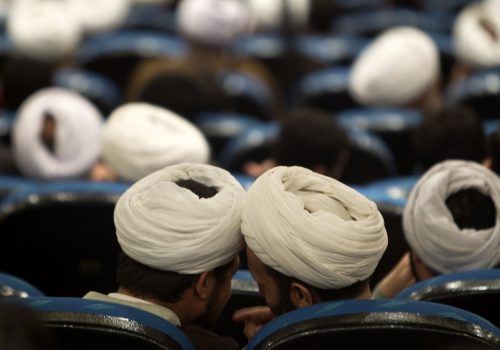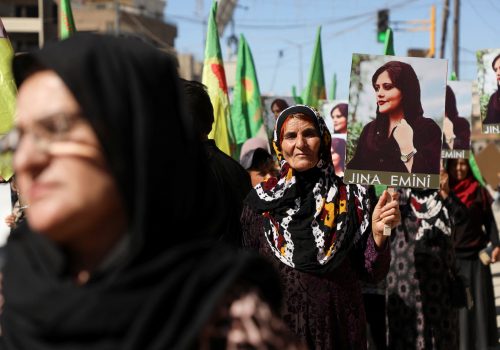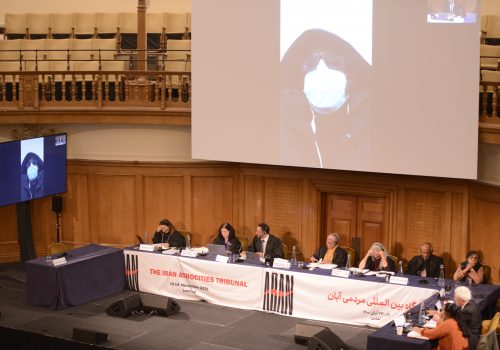Iran’s ‘women, life, freedom’ revolution has a manifesto. Here are the next steps.
On February 13, when I saw the Manifesto for Minimum Demands of Independent Trade Union and Civil Organizations of Iran on Twitter, I was sent back to the early 2000s. I noticed some of the women’s rights organizations I used to work with among the signatories, still braving the dangerous waters of activism in Iran—a strong manifestation of the urgent need for structural changes. As noted in the manifesto, “No clear and attainable vision can be imagined to end [the current crisis] within the framework of the existing political system.”
Signed by twenty organizations and released on February 13, the manifesto soon gathered the support of many other civil society organizations, including another eighteen groups of young activists and university students, which have just been formed over the past five months. These labor, teacher, retiree, women, student, and youth organizations came together in a very dangerous security situation, with at least 530 killed and more than nineteen thousand arrested, according to organization Human Rights Activists in Iran. They offer an articulate and elaborate meaning to the slogan “woman, life, freedom,” aiming to end the formation of any power from above and to establish a society free of oppression, discrimination, tyranny, and dictatorship.
Apart from the significance of listening to the voices of those believing in a fundamental bottom-up change in Iran, what they seek is equally important. The manifesto, which, according to the signatories, is only the beginning of a solidarity-building process, includes many human rights principles, such as non-discrimination, freedom of expression, right to assembly, right to work, absolute prohibition of torture, and abolition of the death penalty. It emphasizes gender equality in law and practice and recognition of the LGBTQ+ community. Highlighting the fact that Iran is a multi-ethnic and multilingual country, it states that the laws and cultural practices that institutionalizes discrimination and oppression against national and religious groups must be eliminated. Some rightly argued that the manifesto should have explicitly mentioned the rights of people with disabilities.
The manifesto seeks a secular state where religion is a private matter and where the country is run by the direct and permanent involvement of people through local and national councils. It puts forth that the people of Iran must have the power to dismiss any government official through voting.
The manifesto’s economic and social components demonstrate a profound alternative to the current situation, which involve measures similar to those implemented in social democracies, including free education and healthcare for everyone, social security, and prohibition of child labor.
As a revolutionary document, the manifesto points out the fact that many individuals and entities have benefited from corruption and the looting of the Iranian people’s resources and wealth over the years. As such, they should be returned to their real owners and spent on rebuilding the educational, health, and environmental infrastructure, particularly in areas disadvantaged under both the Islamic Republic and Shah Mohammad Reza Pahlavi’s regime.
Lastly, the manifesto advocates the need for a nuclear-free Iran and normal relationships with all countries.
The only major flaw of the manifesto is its lack of transitional justice and, in particular, how the signatories envisage dealing with those responsible for human rights abuses. The manifesto was published at a time when Iranian society was heavily debating what to do with officials, including Islamic Revolutionary Guard Corps (IRGC) officers, who want to join the revolution and have been heavily involved in the brutal crackdown on protesters. Should the movement give them a blanket amnesty? Should they be held accountable? Should they at least share the truth about the crimes they have been involved in or are aware of?
These questions have occupied Persian language media and social media spaces in regard to high-profile political figures, such as 2009 Green Movement leader Mir Hossein Mousavi—who has been under house arrest since 2011 and served as prime minister during the mass executions of political prisoners during 1988—and some of the Shah’s officials, such as US-based Parviz Sabeti—the former deputy director of the notorious secret police and security apparatus known as SAVAK, which was responsible for torture and executions—who have both supported the movement in one way or another.
A manifesto of such gravity should have taken a position on such a core issue in the democratization process. At the very least, it should be added to the manifesto in a revised version—there is certainly room for that.
Now that a democratically developed manifesto has attracted the support of many grassroots groups in Iran, the ball is in the exiled opposition’s court. Activists forced to flee Iran in the past four decades now have a choice to make. Whether they will use it as a minimum base for solidarity and coordination between inside and outside forces or issue other manifestos is an open question.
One thing is certain: this revolution began in the streets of Iran led by minorities or minoritized groups and was built on decades of resistance against tyranny. After years of persecution and courage, the same activists I worked with in Iran are beginning to see the light at the end of the tunnel. No opposition will succeed in defeating the Islamic Republic without the blessing and support of those forces.
Shadi Sadr is a human rights lawyer and a member of the panel of judges at the International People’s Tribunals on Indonesia, Myanmar, and China. She co-founded and directed Justice for Iran, one of the organizers of the Iran Atrocities’ (Aban) Tribunal. Follow her on Twitter: @shadisadr.
Further reading
Tue, Nov 22, 2022
Iranians are knocking clerics’ turbans off. This isn’t an anti-religion act but an indirect tool for accountability.
IranSource By
This viral trend of #Turban_Throwing is not an attack against Islam as a religion and faith, but rather a stand against a regime that has used religious practices as a cover to commit unimaginable violence.
Mon, Sep 26, 2022
‘Women, life, liberty’: Iran’s future is female
IranSource By
Women, young and old, have been at the forefront of the uprising, just like every other protest in Iran over the past decades.
Wed, Jan 26, 2022
Aban will not die: How truth remains a powerful weapon against the Islamic Republic
IranSource By
In November 2021, The Iran Atrocities (Aban) Tribunal in London investigated if Iranian government officials, police, and military forces had committed crimes against humanity during the November 2019 protests. In front of the eyes of the Iranian public, bit by bit, pieces of the truth were put together.
Image: February 22, 2023 Rome, Italy - News - demonstration of solidarity with the protest in Iran - In the photo: moments of the demonstration organized in St. John's Square by the Iranian opposition in support of the anti-government demonstrations in Iran (Photo by Mauro Scrobogna/LaPresse/Sipa USA)


